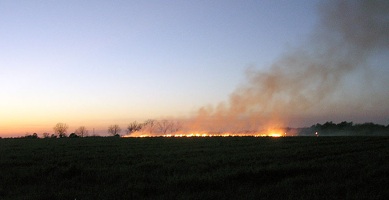
Features
Production
Research
Fire plays role in managing weeds
May 28, 2009 By Weed Science Society of America
 May 28, 2009 – A report published in Weed Science describes how fire
May 28, 2009 – A report published in Weed Science describes how fire
may be used to reduce the number of invasive plant seeds and, as a
result, help restore damaged ecosystems.
May 28, 2009 – A report published in Weed Science describes how fire may be used to reduce the number of invasive plant seeds and, as a result, help restore damaged ecosystems.
 |
|
| A controlled field burn in preparation for spring planting. |
Previous efforts to manage invasive plants focused on eradicating them individually through various means. In addition, it was believed that fires were harmful to plant communities and they were therefore suppressed. Scientists now believe that addressing ecosystems as a whole will yield more successful results and that fire has a role to play in the restoration of these areas that have been heavily invaded by nonnative species.
This research is important because it provides much-needed data obtained from a controlled experiment and adds to the information gathered through observations of grasslands in which the conditions were uncontrolled or unknown.
Different amounts of combustible material, wheat grass in this case, were used to burn seeds from various invasive plant species. The researchers found that 95 to 98 per cent of the seeds did not emerge after burning with as little as 200 grams of wheat grass spread over each square meter of the area burned. These results are promising because most grasslands that have been invaded carry this much or more combustible material. Also, it was determined that seeds near the soil surface were especially susceptible to fire. This is good news, considering that the seeds of most invasive species tend to be found near the soil surface.
A number of factors, including weather patterns, should be considered when using fire to kill invasive plant seeds. When these factors are taken into consideration and when other management techniques, such as chemical treatment, are combined with fire, scientists will be better prepared to obtain optimum results.
In this study, fire was determined to be a powerful tool in minimizing the emergence of invasive plant species from seeds deposited near the soil surface. Scientists will be able to use the results to help plan a successful integrated management system for removing invasive plants.
To read the entire study, “Fire Alters Emergence of Invasive Plant Species from Soil Surface-Deposited Seeds” (Vol. 57.3, 304-310), click here.
Print this page